Numerical Simulation of the Marine Environmental Capacity of Jinpu Bay
Abstract
1. Introduction
2. Materials and Methods
2.1. Overview of the Study Area
2.2. Research Methods
3. Results
3.1. Division of Marine Functional Zones and Water Quality Control Objectives in Jinpu Bay
3.1.1. Determination of Pollution Factors
3.1.2. Setting the Location of Monitoring Points for Measuring Water Quality in Zones
3.2. Calculation of the Marine Environmental Capacity of Jinpu Bay
3.2.1. Calculation of Pollution Response Coefficient
3.2.2. Calculation Results of Marine Environmental Capacity
4. Discussion
5. Conclusions
- (1)
- In the current context, the total nitrogen emission intensity of Jinpu Bay is about 11.5 t/d, the total phosphorus emission intensity is about 0.4 t/d and the COD emission intensity is about 90.3 t/d. Under standard discharge, the allowable emission intensity values of total nitrogen, total phosphorus and COD in Jinpu Bay are about 9.3 t/d, 0.5 t/d and 138.8 t/d. The numerical results show that the total nitrogen emissions in Jinpu Bay exceed the standard, and its emission intensity should be reduced by 2.2 t/d. Regarding the total phosphorus and COD emissions in Jinpu Bay, the remaining capacity demonstrates that the total phosphorus emission intensity can be increased by about 0.1 t/d, and the COD emission intensity can be increased by about 48.5 t/d;
- (2)
- In terms of total nitrogen emissions, the Weitang River, Laogu River, Dengtun River, Anzi River, Shihe River, Sanshili River and the Dahua sewage outlet need to reduce their emission intensities, while the Daweijia River, Beida River, Xiajia River and Muchengyi River still have some residual capacity. In terms of total phosphorus discharge, the Laogu River, Dengtun River, Anzi River, Shihe River, Sanshili River and the Dahua outlet need to reduce their discharge intensities, while the Weitang River, Daweijia River, Beida River, Xiajia River and Muchengyi River still have some residual capacity. In terms of COD discharge, aside from the need to reduce the discharge intensity at Shihe River, the other rivers and the Dahua sewage discharge outlet still have a certain residual capacity;
- (3)
- The research results can not only reveal the diffusion of marine pollutants and the marine environmental capacity of Jinpu Bay, but also a technical reference is provided for the economic development of the region and the formulation of pollutant emission control policies.
Author Contributions
Funding
Data Availability Statement
Acknowledgments
Conflicts of Interest
References
- Sun, L.; Wang, J.; Zhang, H.; Xu, M. Characteristics and Mechanism of the Environmental Capacity Changes in Haizhou Bay, Northern Jiangsu, China from 2006 to 2016. Water 2020, 12, 2990. [Google Scholar] [CrossRef]
- Halpern, B.S.; Walbridge, S.; Selkoe, K.A.; Kappel, C.V.; Micheli, F.; D’Agrosa, C.; Bruno, J.F.; Casey, K.S.; Ebert, C.; Fox, H.E.; et al. A global map of human impact on marine ecosystems. Science 2008, 319, 948–952. [Google Scholar] [CrossRef]
- Syvitski, J.P.M.; Vörösmarty, C.J.; Kettner, A.J.; Green, P. Impact of Humans on the Flux of Terrestrial Sediment to the Global Coastal Ocean. Science 2005, 308, 376–380. [Google Scholar] [CrossRef]
- Zhang, Y.; Zhang, D. Coastal zones—Key areas for global change research. Ocean. Bull. 1993, 16, 69–80. [Google Scholar]
- Wang, Z. Ocean Action Plan for the 21st Century. Ocean. Dev. Manag. 1995, 12, 15. [Google Scholar]
- Linker, L.C.; Batiuk, R.A.; Shenk, G.W.; Cerco, C.F. Development of the Chesapeake Bay Watershed Total Maximum Daily Load Allocation. JAWRA J. Am. Water Resour. Assoc. 2013, 49, 986–1006. [Google Scholar] [CrossRef]
- Wu, Y. The profound significance of coastal zone research. Earth Inf. Sci. 1997, 2, 55–56. [Google Scholar]
- Barberi, S.; Sambito, M.; Neduzha, L.; Severino, A. Pollutant Emissions in Ports: A Comprehensive Review. Infrastructures 2021, 6, 114. [Google Scholar] [CrossRef]
- Merico, E.; Dinoi, A.; Contini, D. Development of an Integrated Modelling-Measurement System for Near-Real-Time Estimates of Harbor Activity Impact to the Atmospheric Pollution in Coastal Cities. Transp. Res. Part. D 2019, 73, 108–119. [Google Scholar] [CrossRef]
- Trela, J.; Płaza, E. Innovative technologies in municipal wastewater treatment plants in Sweden to improve Baltic Sea water quality. Proc. E3S Web Conf. 2018, 45, 113. [Google Scholar] [CrossRef]
- Margeta, J.; Baric, A.; Gacic, M. Environmental capacity of the Kastela Bay. In Proceedings of the Eighth International Ocean Disposal Symposium, Dubrovnik, Yugoslavia, 9–13 October 1989; pp. 9–13. [Google Scholar]
- Horiya, K.; Hirano, T.; Hosoda, M.; Hirano, T. Evaluating Method of the Marine Environmental Capacity for Coastal Fisheries and Its Application to Osaka Bay. Mar. Pollut. Bull. 1991, 23, 253–257. [Google Scholar] [CrossRef]
- Ernestova, L.S. The Effect of Photochemical Oxygen Activation Products on the Self-purification Capacity of Natural Waters. Water Resour. 1994, 21, 334–338. [Google Scholar]
- Krom, M.D.; Hornung, H.; Cohen, Y. Determination of the environmental capacity of Haifa Bay with respect to the input of mercury. Mar. Pollut. Bull. 1990, 21, 349–354. [Google Scholar] [CrossRef]
- Duka, G.G.; Goryacheva, N.V.; Romanchuk, L.S. Investigation of natural water self-purification capacity under simulated conditions. Water Resour. 1996, 23, 619–622. [Google Scholar]
- Zhang, C.; Xia, J. Research on the total amount control of pollution emissions in Dalian Bay: A calculation model for the bay’s pollution carrying capacity. Mar. Environ. Sci. 1998, 17, 1–5. [Google Scholar]
- Zhang, Y.; Sun, Y. Application of estuarine, continental shelf, and oceanic models in Jiaozhou Bay. Mar. Environ. Sci. 2000, 19, 13–17. [Google Scholar]
- Zhao, L.; Wei, H.; Zhao, J. Numerical study of water exchange in Jiaozhou Bay. Ocean. Limnol. 2002, 33, 23–29. [Google Scholar]
- Jiang, F. Study on the Exchange Rate and Flux of Nutrients at the Sediment Seawater Interface in Jiaozhou Bay. Master’s Thesis, Qingdao Ocean University, Qingdao, China, 2002. [Google Scholar]
- Ge, M.; Wang, X.; Yan, J.; Shi, X.; Zhu, C.; Jiang, F. Calculation of Nutrient Environmental Capacity in Jiaozhou Bay. Ocean. Sci. 2003, 27, 36–42. [Google Scholar]
- Change, D.; Jitang, L.; Jikun, L.; Haibin, L.; Huijuan, T. Water quality investigation research in guan river sea area. Environ. Sci. Manag. 2007, 32, 29–32. [Google Scholar]
- Cui, C.; Hua, W.; Yuan, G.; Jiao, X.; Fang, N.; Lu, Y.; Zhang, X.; Mao, C. Survey and evaluation on water quality of coastal area in guanhe estuary. China Resour. Compr. Util. 2013, 31, 41–44. [Google Scholar]
- Liu, H.; Dai, M.X.; Peng, S.T.; Xu, W.S. Estimation of the environment capacity of the major pollutants in the bohai bay. Mar. Sci. Bull. 2011, 30, 451–455. [Google Scholar]
- Rlfer, L.; Liconti, A.; Prinz, N.; Klcker, C.A. Integrated research for integrated ocean management. Front. Mar. Sci. 2021, 8, 1094. [Google Scholar] [CrossRef]
- Sangha, K.K.; Stoeckl, N.; Crossman, N.; Costanza, R. A state-wide economic assessment of coastal and marine ecosystem services to inform sustainable development policies in the Northern Territory, Australia. Mar. Policy 2019, 107, 103595. [Google Scholar] [CrossRef]
- Shao, Q.; Liu, X.; Zhao, W. An alternative method for analyzing dimensional interactions of urban carrying capacity: Case study of Guangdong-Hong Kong-Macao Greater Bay Area. J. Environ. Manag. 2020, 273, 111064. [Google Scholar] [CrossRef]
- Culhane, F.E.; Frid, C.L.; Gelabert, E.R.; Piet, G.; White, L.; Robinson, L.A. Assessing the capacity of European regional seas to supply ecosystem services using marine status assessments. Ocean Coast. Manag. 2020, 190, 105154. [Google Scholar] [CrossRef]
- Song, M.; Pan, X.; Pan, X. Assessment of China’s marine ecological carrying capacity. In Sustainable Marine Resource Utilization in China; Elsevier: Amsterdam, The Netherlands, 2020; pp. 29–62. [Google Scholar]
- Yao, Y.; Zhu, J.; Li, L.; Wang, J.; Yuan, J. Marine Environmental Capacity in Sanmen Bay, China. Water 2022, 14, 2083. [Google Scholar] [CrossRef]
- Bui, L.T.; Tran, D.L.T. Assessing marine environmental carrying capacity in semi-enclosed coastal areas—Models and related databases. Sci. Total. Environ. 2022, 838 Pt 1, 156043. [Google Scholar] [CrossRef] [PubMed]
- Luo, F.; Gou, H.; Li, R.; Wang, H.; Chen, Z.; Lin, W.; Li, K. Numerical simulation on marine environmental capacity in the open sea area of Northern Jiangsu Province using a three-dimensional water quality model based on FVCOM. Reg. Stud. Mar. Sci. 2021, 45, 101856. [Google Scholar] [CrossRef]
- Ma, R.; Ji, S.; Ma, J.; Shao, Z.; Zhu, B.; Ren, L.; Li, J.; Liu, L. Exploring resource and environmental carrying capacity and suitability for use in marine spatial planning: A case study of Wenzhou, China. Ocean Coast. Manag. 2022, 226, 106258. [Google Scholar] [CrossRef]
- Yin, G.; Hou, L.; Zong, H.; Ding, P.; Liu, M.; Zhang, S.; Cheng, X.; Zhou, J. The spatiotemporal distribution characteristics and eutrophication status of surface seawater N and P content in Jinpu Bay, Dalian. Mar. Environ. Sci. 2013, 32, 4. [Google Scholar]
- Soltani, P.; Askar, M.B.; Bahrami, H.; Pour, S.H. Evaluation of Sediment Transport in the Naiband Gulf Area Using Mike21. Open J. Geol. 2017, 7, 182–192. [Google Scholar] [CrossRef]
- Zhang, X.; Wu, X.; Zhu, G.; Wang, T.; Chen, H. Simulation of diffuse source polluted water environment based on MIKE21: A case study of the urban section of the Bai river. Water Pr. Technol. 2022, 17, 1893–1913. [Google Scholar] [CrossRef]
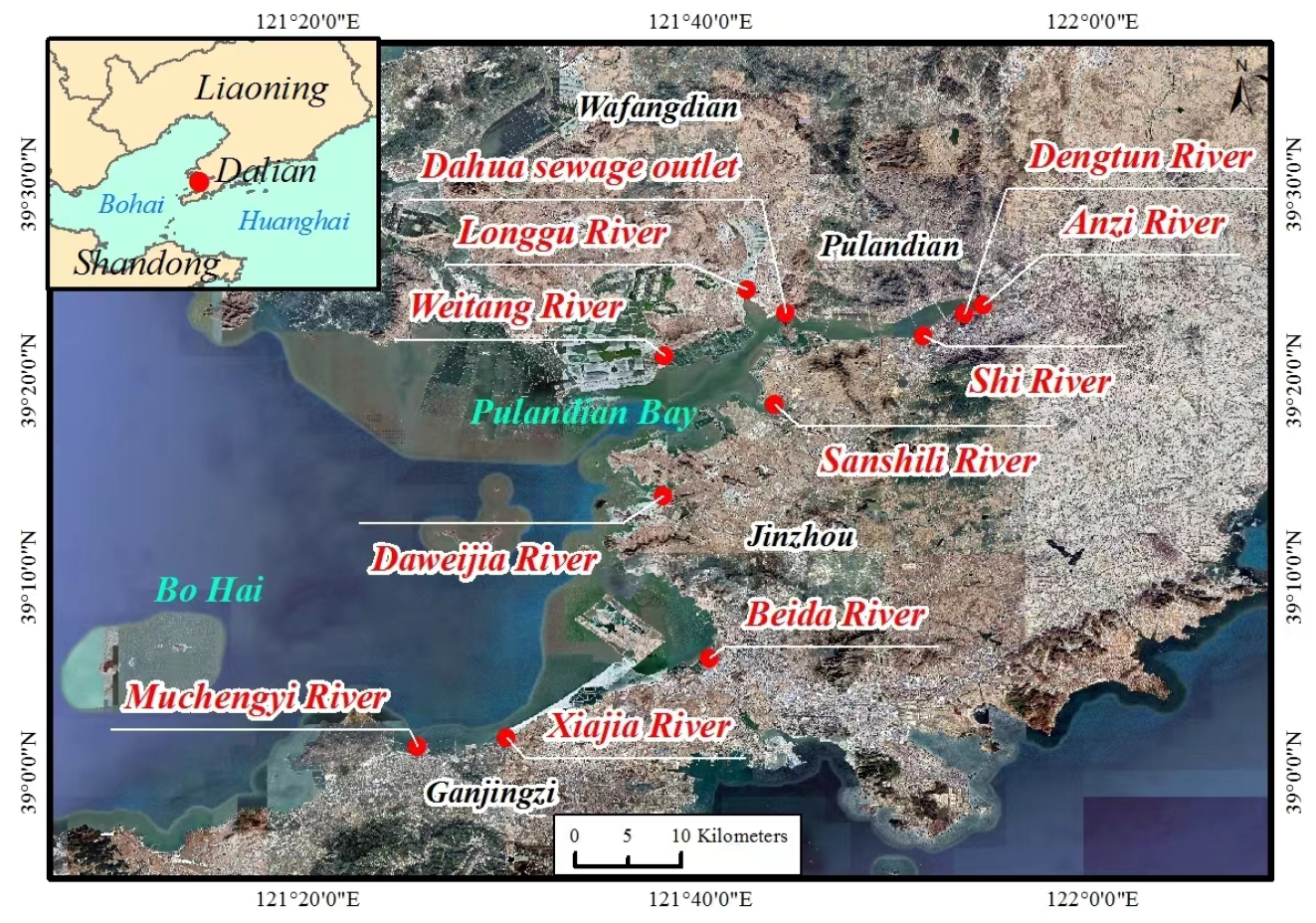

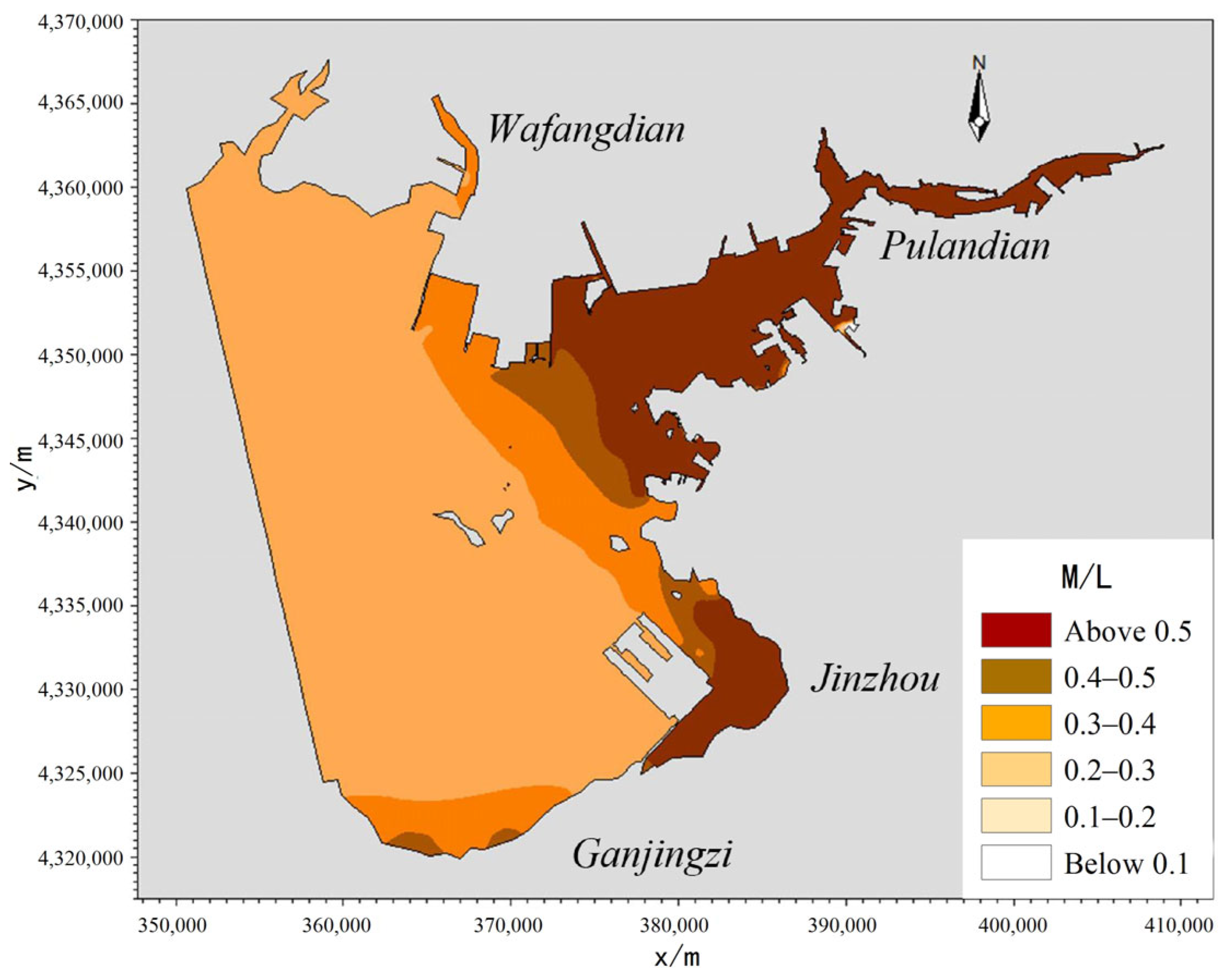



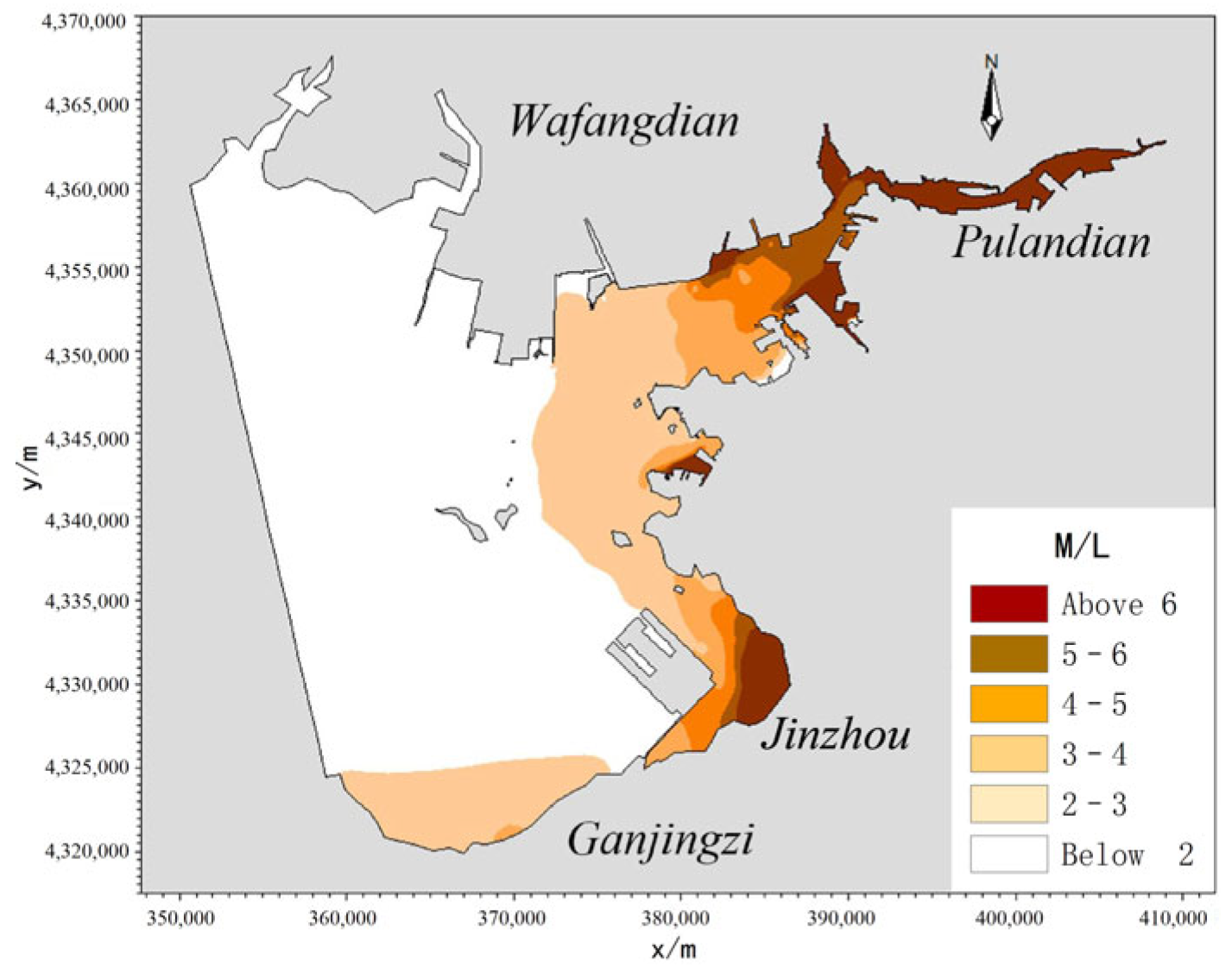

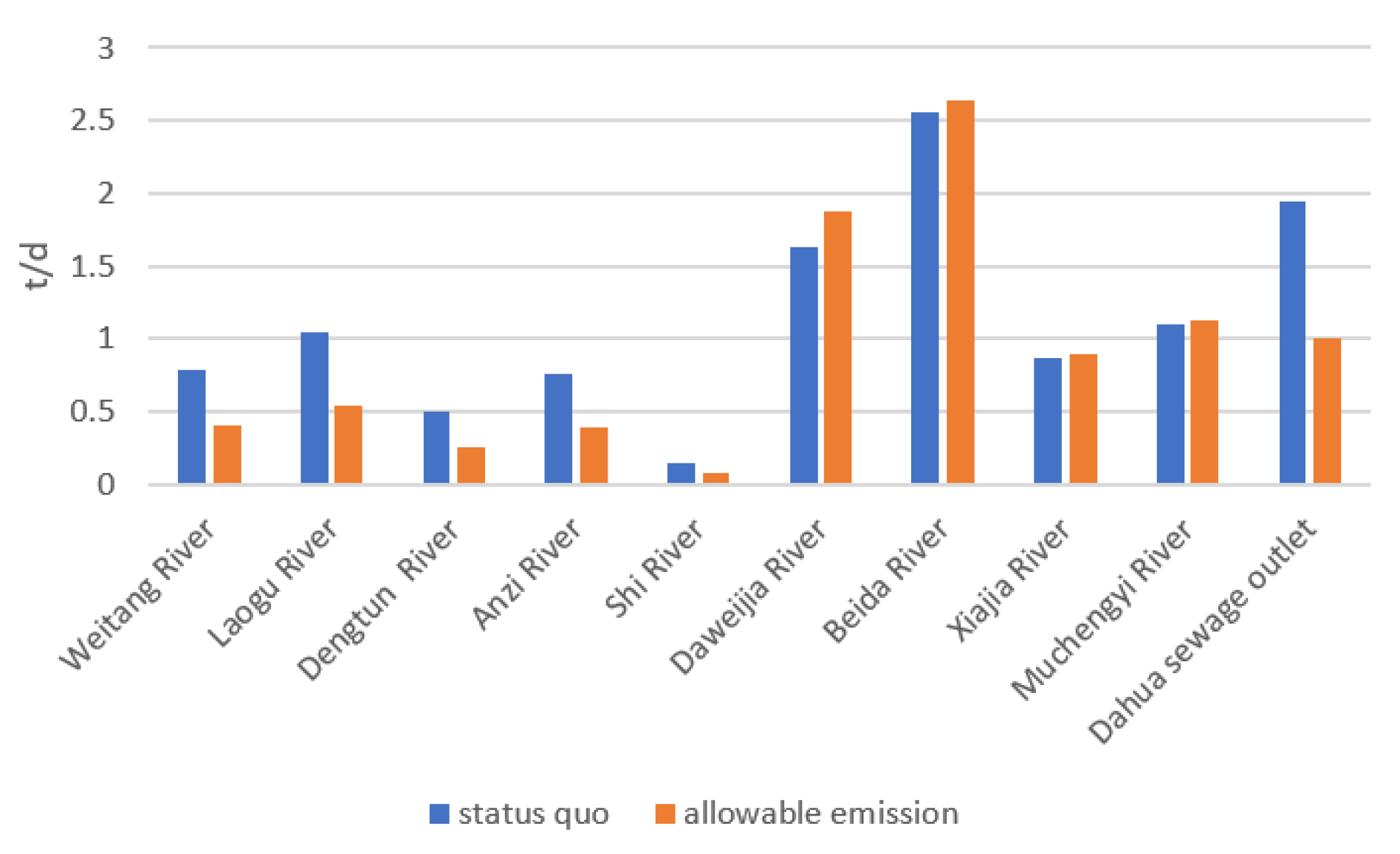

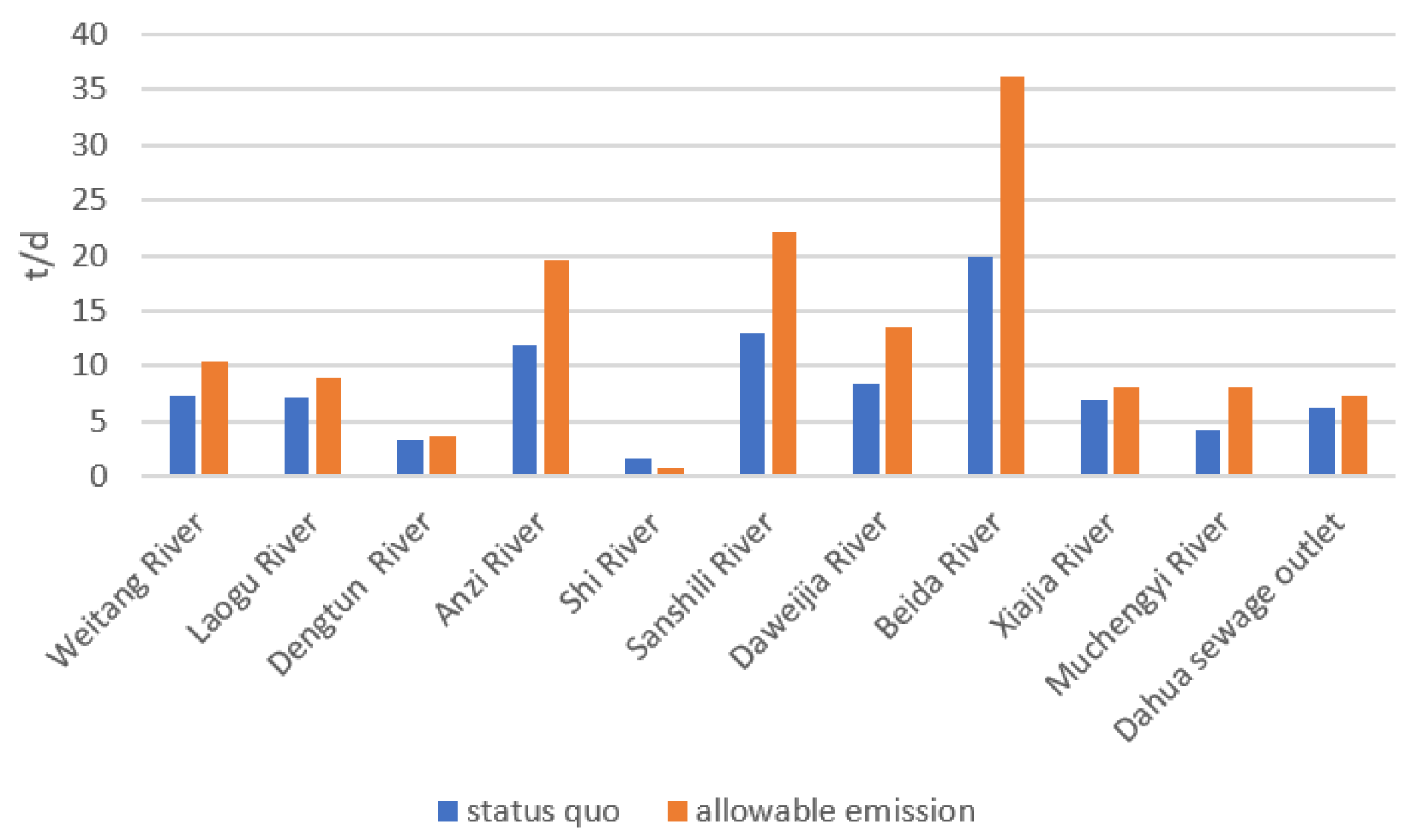
| Administration Regionalization | Monitoring Point | Pollutant Monitoring Results (unit: mg/L) | |||||||||||
|---|---|---|---|---|---|---|---|---|---|---|---|---|---|
| Chemical Oxygen Demand | Total Nitrogen | Total Phosphorus | |||||||||||
| Q1 | Q2 | Q3 | Q4 | Q1 | Q2 | Q3 | Q4 | Q1 | Q2 | Q3 | Q4 | ||
| Jinpu New District | Shi River | - | 29.0 | - | 40.0 | - | 1.0 | - | 4.9 | - | 0.1 | - | 0.0 |
| Daweijia River | 42.0 | 137.0 | 40.0 | 44.0 | 16.8 | 22.0 | 4.98 | 7.0 | 0.8 | 3.2 | 0.5 | 0.9 | |
| Wushili River | - | - | - | - | - | - | - | - | - | - | - | - | |
| Dengtun River | 46.0 | 36.0 | 47.0 | 29.0 | 5.0 | 7.2 | 4.3 | 7.1 | 0.1 | 0.2 | 0.1 | 0.4 | |
| Weitang River | 115.0 | 49.0 | 30.0 | - | 4.8 | 8.4 | 7.7 | - | 0.1 | 0.2 | 0.0 | - | |
| Laogu River | 116.0 | 30.0 | 46.0 | 30.0 | 5.8 | 8.2 | 10.7 | 7.6 | 0.1 | 0.1 | 0.1 | 0.2 | |
| Sanshili River | - | - | - | 43.0 | - | - | - | 0.6 | - | - | - | 0.1 | |
| Dahua Outlet | 44.0 | 32.0 | 29.9 | 38.0 | 11.6 | 11.2 | 14.6 | 7.7 | 0.1 | 0.1 | 0.4 | 0.1 | |
| Beida River | 39.0 | 45.0 | 248.0 | 43.0 | 10.1 | 14.8 | 10.0 | 13.0 | 0.1 | 0.1 | 0.9 | 0.3 | |
| Hongqi River | 34.0 | 35.0 | 28.1 | 22.5 | 4.9 | 2.3 | 3.1 | 2.3 | |||||
| Pulandian | Anzi River | 83.2 | 95.4 | 86.4 | 36.9 | 3.6 | 2.6 | 9.1 | 4.0 | 0.2 | 0.3 | 0.5 | 0.1 |
| Serial Number | Local Sea Area | Water Quality | Inorganic Nitrogen (mg/L) | COD (mg/L) | Active Phosphate (in P) (mg/L) |
|---|---|---|---|---|---|
| 1 | Pulandian Bay | IV | ≤0.5 | ≤5 | ≤0.045 |
| 2 | IV | ≤0.5 | ≤5 | ≤0.045 | |
| 3 | II | ≤0.3 | ≤3 | ≤0.030 | |
| 4 | I | ≤0.2 | ≤2 | ≤0.015 | |
| 5 | II | ≤0.3 | ≤3 | ≤0.030 | |
| 6 | I | ≤0.2 | ≤2 | ≤0.015 | |
| 13 | IV | ≤0.5 | ≤5 | ≤0.045 | |
| 7 | Jinzhou Bay | I | ≤0.2 | ≤2 | ≤0.015 |
| 8 | II | ≤0.3 | ≤3 | ≤0.030 | |
| 9 | III | ≤0.4 | ≤4 | ≤0.030 | |
| 10 | I | ≤0.2 | ≤2 | ≤0.015 | |
| 11 | I | ≤0.2 | ≤2 | ≤0.015 | |
| 12 | II | ≤0.3 | ≤3 | ≤0.030 |
| Monitoring Point | 1 | 2 | 3 | 4 | 5 | 6 | 7 | 8 | 9 | 10 | 11 | 12 | 13 | |
|---|---|---|---|---|---|---|---|---|---|---|---|---|---|---|
| Sewage Outlet | ||||||||||||||
| Weitang River | 0.051 | 0.055 | 0.080 | 0.019 | 0.027 | 0.006 | 0.001 | 0.000 | 0.000 | 0.000 | 0.000 | 0.001 | 0.010 | |
| Laogu River | 0.125 | 0.099 | 0.044 | 0.005 | 0.010 | 0.001 | 0.000 | 0.000 | 0.000 | 0.000 | 0.000 | 0.000 | 0.032 | |
| Dengtun River | 0.028 | 0.018 | 0.005 | 0.000 | 0.001 | 0.000 | 0.000 | 0.000 | 0.000 | 0.000 | 0.000 | 0.000 | 0.405 | |
| Anzi River | 0.027 | 0.017 | 0.005 | 0.000 | 0.001 | 0.000 | 0.000 | 0.000 | 0.000 | 0.000 | 0.000 | 0.000 | 0.394 | |
| Shi River | 0.079 | 0.057 | 0.020 | 0.002 | 0.004 | 0.001 | 0.000 | 0.000 | 0.000 | 0.000 | 0.000 | 0.000 | 0.483 | |
| Sanshili River | 0.096 | 0.014 | 0.007 | 0.001 | 0.002 | 0.000 | 0.000 | 0.000 | 0.000 | 0.000 | 0.000 | 0.000 | 0.002 | |
| Daweijia River | 0.002 | 0.002 | 0.007 | 0.013 | 0.025 | 0.013 | 0.016 | 0.001 | 0.001 | 0.000 | 0.000 | 0.002 | 0.000 | |
| Beida River | 0.001 | 0.001 | 0.003 | 0.006 | 0.009 | 0.007 | 0.026 | 0.107 | 0.108 | 0.002 | 0.000 | 0.001 | 0.000 | |
| Xiajia River | 0.000 | 0.000 | 0.000 | 0.001 | 0.001 | 0.002 | 0.005 | 0.006 | 0.005 | 0.015 | 0.015 | 0.003 | 0.000 | |
| Muchengyi River | 0.000 | 0.000 | 0.001 | 0.002 | 0.002 | 0.006 | 0.010 | 0.010 | 0.008 | 0.014 | 0.034 | 0.007 | 0.000 | |
| Dahua Sewage Outlet | 0.180 | 0.131 | 0.053 | 0.006 | 0.013 | 0.002 | 0.000 | 0.000 | 0.000 | 0.000 | 0.000 | 0.000 | 0.065 | |
| Monitoring Point | 1 | 2 | 3 | 4 | 5 | 6 | 7 | 8 | 9 | 10 | 11 | 12 | 13 | |
|---|---|---|---|---|---|---|---|---|---|---|---|---|---|---|
| Sewage Outlet | ||||||||||||||
| Weitang River | 0.051 | 0.055 | 0.080 | 0.019 | 0.027 | 0.006 | 0.001 | 0.000 | 0.000 | 0.000 | 0.000 | 0.001 | 0.010 | |
| Laogu River | 0.125 | 0.099 | 0.044 | 0.005 | 0.010 | 0.001 | 0.000 | 0.000 | 0.000 | 0.000 | 0.000 | 0.000 | 0.032 | |
| Dengtun River | 0.028 | 0.018 | 0.005 | 0.000 | 0.001 | 0.000 | 0.000 | 0.000 | 0.000 | 0.000 | 0.000 | 0.000 | 0.405 | |
| Anzi River | 0.027 | 0.017 | 0.005 | 0.000 | 0.001 | 0.000 | 0.000 | 0.000 | 0.000 | 0.000 | 0.000 | 0.000 | 0.394 | |
| Shi River | 0.079 | 0.057 | 0.020 | 0.002 | 0.004 | 0.001 | 0.000 | 0.000 | 0.000 | 0.000 | 0.000 | 0.000 | 0.483 | |
| Sanshili River | 0.100 | 0.146 | 0.073 | 0.011 | 0.021 | 0.004 | 0.001 | 0.000 | 0.000 | 0.000 | 0.000 | 0.000 | 0.023 | |
| Daweijia River | 0.002 | 0.002 | 0.007 | 0.013 | 0.025 | 0.013 | 0.016 | 0.001 | 0.001 | 0.000 | 0.000 | 0.002 | 0.000 | |
| Beida River | 0.001 | 0.001 | 0.003 | 0.006 | 0.009 | 0.007 | 0.026 | 0.107 | 0.108 | 0.002 | 0.000 | 0.001 | 0.000 | |
| Xiajia River | 0.000 | 0.000 | 0.000 | 0.001 | 0.001 | 0.002 | 0.005 | 0.006 | 0.005 | 0.015 | 0.015 | 0.003 | 0.000 | |
| Muchengyi River | 0.000 | 0.000 | 0.001 | 0.002 | 0.002 | 0.006 | 0.010 | 0.010 | 0.008 | 0.014 | 0.034 | 0.007 | 0.000 | |
| Dahua Sewage Outlet | 0.180 | 0.131 | 0.053 | 0.006 | 0.013 | 0.002 | 0.000 | 0.000 | 0.000 | 0.000 | 0.000 | 0.000 | 0.065 | |
| Monitoring Point | 1 | 2 | 3 | 4 | 5 | 6 | 7 | 8 | 9 | 10 | 11 | 12 | 13 | |
|---|---|---|---|---|---|---|---|---|---|---|---|---|---|---|
| Sewage Outlet | ||||||||||||||
| Weitang River | 0.772 | 0.760 | 0.479 | 0.286 | 0.340 | 0.268 | 0.321 | 0.520 | 0.521 | 0.245 | 0.249 | 0.230 | 1.327 | |
| Laogu River | 0.707 | 0.724 | 0.521 | 0.303 | 0.362 | 0.275 | 0.325 | 0.525 | 0.526 | 0.247 | 0.252 | 0.233 | 1.318 | |
| Dengtun River | 1.769 | 1.761 | 1.215 | 0.665 | 0.802 | 0.597 | 0.702 | 1.136 | 1.137 | 0.534 | 0.544 | 0.505 | 2.512 | |
| Anzi River | 0.477 | 0.481 | 0.337 | 0.186 | 0.224 | 0.167 | 0.197 | 0.318 | 0.319 | 0.150 | 0.153 | 0.141 | 0.424 | |
| Shi River | 3.379 | 3.367 | 2.329 | 1.279 | 1.541 | 1.149 | 1.352 | 2.186 | 2.188 | 1.027 | 1.048 | 0.971 | 5.131 | |
| Sanshili River | 0.355 | 0.305 | 0.236 | 0.158 | 0.183 | 0.148 | 0.178 | 0.289 | 0.289 | 0.136 | 0.139 | 0.128 | 0.719 | |
| Daweijia River | 0.709 | 0.702 | 0.476 | 0.250 | 0.293 | 0.224 | 0.261 | 0.449 | 0.449 | 0.211 | 0.215 | 0.198 | 1.154 | |
| Beida River | 0.298 | 0.295 | 0.200 | 0.105 | 0.125 | 0.093 | 0.090 | 0.082 | 0.081 | 0.087 | 0.090 | 0.083 | 0.485 | |
| Xiajia River | 0.858 | 0.850 | 0.583 | 0.317 | 0.382 | 0.283 | 0.330 | 0.536 | 0.538 | 0.240 | 0.245 | 0.239 | 1.394 | |
| Muchengyi River | 1.401 | 1.387 | 0.951 | 0.517 | 0.624 | 0.460 | 0.538 | 0.875 | 0.878 | 0.402 | 0.391 | 0.387 | 2.274 | |
| Dahua Sewage Outlet | 0.781 | 0.821 | 0.600 | 0.350 | 0.417 | 0.318 | 0.376 | 0.608 | 0.608 | 0.286 | 0.291 | 0.270 | 1.497 | |
| Pollutant | Sewage Outlet | |||||||||||
|---|---|---|---|---|---|---|---|---|---|---|---|---|
| Weitang River | Laogu River | Dengtun River | Anzi River | Shi River | Sanshili River | Daweijia River | Beida River | Xiajia River | Muchengyi River | Dahua | Gross Amount | |
| Total Nitrogen | 0.784 | 1.047 | 0.497 | 0.761 | 0.146 | 0.195 | 1.625 | 2.553 | 0.864 | 1.093 | 1.950 | 11.515 |
| Total Phosphorus | 0.012 | 0.017 | 0.017 | 0.042 | 0.003 | 0.015 | 0.173 | 0.071 | 0.053 | 0.008 | 0.025 | 0.435 |
| COD | 7.263 | 7.193 | 3.327 | 11.868 | 1.729 | 13.078 | 8.408 | 20.007 | 6.964 | 4.268 | 6.216 | 90.321 |
| Pollutant | Sewage Outlet | |||||||||||
|---|---|---|---|---|---|---|---|---|---|---|---|---|
| Weitang River | Laogu River | Dengtun River | Anzi River | Shi River | Sanshili River | Daweijia River | Beida River | Xiajia River | Muchengyi River | Dahua | Gross Amount | |
| Total Nitrogen | 0.402 | 0.536 | 0.255 | 0.390 | 0.075 | 0.159 | 1.876 | 2.635 | 0.891 | 1.127 | 0.999 | 9.346 |
| Total Phosphorus | 0.014 | 0.017 | 0.017 | 0.041 | 0.003 | 0.015 | 0.208 | 0.085 | 0.064 | 0.009 | 0.025 | 0.497 |
| COD | 10.465 | 9.038 | 3.800 | 19.532 | 0.737 | 22.184 | 13.616 | 36.048 | 7.995 | 7.999 | 7.414 | 138.828 |
Disclaimer/Publisher’s Note: The statements, opinions and data contained in all publications are solely those of the individual author(s) and contributor(s) and not of MDPI and/or the editor(s). MDPI and/or the editor(s) disclaim responsibility for any injury to people or property resulting from any ideas, methods, instructions or products referred to in the content. |
© 2024 by the authors. Licensee MDPI, Basel, Switzerland. This article is an open access article distributed under the terms and conditions of the Creative Commons Attribution (CC BY) license (https://creativecommons.org/licenses/by/4.0/).
Share and Cite
Hao, Y.; Cui, L.; Zhang, P.; Huang, J.; Yan, J.; Jiang, H. Numerical Simulation of the Marine Environmental Capacity of Jinpu Bay. Water 2024, 16, 404. https://doi.org/10.3390/w16030404
Hao Y, Cui L, Zhang P, Huang J, Yan J, Jiang H. Numerical Simulation of the Marine Environmental Capacity of Jinpu Bay. Water. 2024; 16(3):404. https://doi.org/10.3390/w16030404
Chicago/Turabian StyleHao, Yanni, Lei Cui, Pan Zhang, Jie Huang, Jishun Yan, and Hengzhi Jiang. 2024. "Numerical Simulation of the Marine Environmental Capacity of Jinpu Bay" Water 16, no. 3: 404. https://doi.org/10.3390/w16030404
APA StyleHao, Y., Cui, L., Zhang, P., Huang, J., Yan, J., & Jiang, H. (2024). Numerical Simulation of the Marine Environmental Capacity of Jinpu Bay. Water, 16(3), 404. https://doi.org/10.3390/w16030404








